

Discordian Buddhism is a single grain of rice with a side of apple.
It's Buddhism. Discordianism is basically Zen Buddhism to begin with, I'm just emphasizing the Buddhist parts.
No, it's a secular spiritual practice disguised as a joke disguised as a religion.
It doesn't matter. Buddhism exists with or without the historical Buddha, just as Discordianism exists with or without a literal Eris. Rather than waste time debating things that do not matter, we say "As if."
Yes, it is. It's also the philosophical idea developed by Hans Vaihinger. Essentially, it states that reality is so impossibly complicated, and since it's impossible to actually know anything for sure, it falls to society to behave "as if" certain agreed-upon tenets were true. In the case of Discordian Buddhism, we proceed in our faith as if the historical Buddha existed, and as if Chaos Buddha exists, and that's good enough for us.
I am Discordian because I recognize the fundamental nature of Chaos, not because I'm a comedian. I also love the funny stuff, humor absolutely belongs in religion, but this particular treatise may not be the rollicking laugh-a-minute showboat you'd expect if you've only read the Principia. Discordians are philosophers and spiritual seekers, too.
That's cool.
I thought you'd never ask. Here we go.

Buddhism teaches that all people are inherently Buddhas.
Discordianism teaches that all people are inherently Chaos.
Discordian Buddhism teaches that all people are inherently Chaos Buddhas.
You are.
You may know of some of the Buddhas who exist already - Bhaisajyaguru the Medicine Buddha, Amitabha Buddha the Buddha of Infinite Light, and so on. The Chaos Buddha is the Buddha who hears only the hum of Primordial Chaos in all things. This is the Buddha who embodies emptiness, sunyata. The purest expression of your Bodhichitta, Buddha Nature, is your Chaos Buddha Nature.
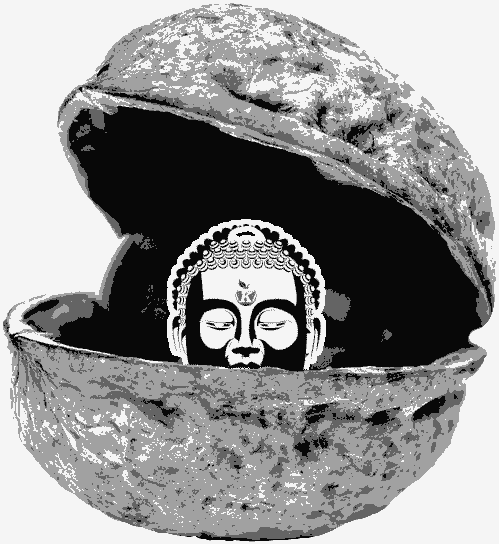
Hello, I'm in a nutshell.
-- Chaos Buddha in a Nutshell
There is no logical structure, no path of reason or philosophy, no scientific discipline, no course of study, no scripture, no tradition, and no teacher that will lead naturally to the realization of primordial Chaos. The only path to the realization of Chaos is by listening to it. The Song of Eris hums under everything.
Every word is like an unnecessary stain on silence and nothingness.
-- Samuel Beckett
When I say "listen," I don't mean in your ears. I mean with your attention, with your attentiveness, with your consciousness. We're constantly listening, usually to our own thoughts, which run without ceasing and drown out everything else. Once we learn to quiet those, or at least ignore them, we can listen to something deeper. We may listen to a mantra, or to our own breathing, but true listening is beyond this. We can listen to the ambient sounds of the room, the fan whirring, a cat padding over the floor to get to a food dish, but true listening is beyond even this.
When we are truly listening, we can hear the electrons whirling around our atoms. We can hear the Strong and Weak Nuclear forces holding the nuclei together. We can hear the fluctuations of the quantum foam under everything, and it is then, only then, that oneness is realized. When we can hear the same quantum-scale cacophony in every part of the world as in ourselves, when we realize that the thing that we call "myself" is a sound undistinguishable from the sound of everything else, when we hear the inherent, delicate, unceasing hum of the Chaos underneath all things, that is when Chaos Buddha Nature truly begins to arise.
The Buddha instructed his students to abolish the lesser rules if necessary to spread the Dharma, and left no instructions as to which rules were the 'lesser' ones.
It turns out they're all lesser rules.
The only requirement is listening, and whatever is required for listening. Becoming vegetarian, or giving up intoxicants, because you're told to by a teacher or organization will only bind your focus to the restriction itself, when the goal is to focus on Chaos. If you find that intoxicants hinder your ability to focus on the Chaos under every moment, you may on your own decide to give that up. If you find that you're able to meditate and also consume intoxicants, or if you find intoxicants helpful (hint: addiction is not helpful, please hullaballoo responsibly), there is no need to renounce such things. Realization is the goal, not renunciation.
We do not take vows in Discordian Buddhism, because vows are superficial and generally only serve the ego. The only value in a vow is in understanding why it has been taken, and this is only possible through experience.
Unbroken vows are purposeless.
True enlightenment is conscious heresy.
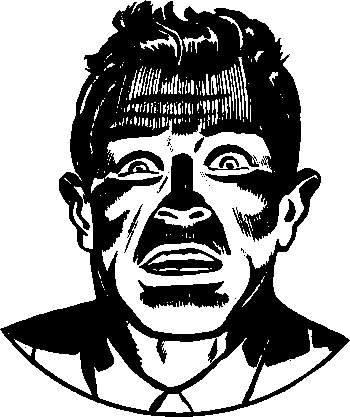
Conscious Heresy is central to the path of the Discordian Buddhist. Heresy for heresy's sake can certainly be entertaining, but we are interested in outcomes. The path to realization respects no vows, no restrictions, no rules, and no traditions. The path to Chaos is always in motion. Rigid paths are by definition limiting, and necessarily Aneristic.
Slavish devotion to vices, like gambling, sex, and intoxication, can be detrimental to realization and growth. Similarly, slavish devotion to the avoidance of these activities can be similarly detrimental. This is particularly true when members of a spiritual community take it upon themselves to police the activities of its members. The result of this is always harmful.
Renunciation or indulgence: either choice, taken wholesale, is insufficient. Chaos is not a path of absolutes. Chaos is inherent in all things and also in their absence, if one only stops to consciously listen.
All objects and phenomena, all light, heat, and sound, and every particle of matter, whether a piece of a building, vehicle, or body, is nothing more than carefully constrained and quantized Chaos. Every mechanism, chemical, action, reaction, and interaction which makes our bodies function; every neuron and synapse; the nucleus of every atom; all are essentially meaningless, ascribed meaning only by virtue of the role they play in the ongoing functions of observed reality.
Every speck, however minute, of every moment, however brief, is nothing more than Chaos playing the role of that speck; that moment.
Meaninglessness is stacked on Meaninglessness, until meaning can be applied: Up-quark. Down-quark. Proton. Electron. Atom. Carbon. Hydrocarbon. Cell. Alveolus. Bronchiole. Lung. Human.
Whether these meanings, these functions, are assigned purely by an accident of physics, or with some purpose, is unknown to us at this time.
The inherent Meaninglessness of all things is the sole doctrine of Discordian Buddhism. Nothing else of consequence can be said with any authority.
The Sanskrit word Nairarthya means "Meaninglessness." Whereas the Sanskrit "Namaste" ("I bow to you") is commonly used as a greeting, Discordian Buddhists may use "Nairarthya" similarly, recognizing that any two people meeting each other are essentially the same Chaos, indistinct and meaningless, ascribed meaning only by virtue of their quantized and constrained forms, together with their relative proximity in time and space.
The Precepts taught by the Buddha are not commandments and never were - even if several of them, like not killing, not stealing, and not lying, are generally good ideas. However, there are times when it is justifiable to kill, as in self-defense; to steal, as in stealing food to prevent starving; and to lie, when the truth will cause undue harm. Again, unbroken vows are purposeless. The key is in knowing when to break them.
As a Discordian Buddhist, I will always look at the Precepts as generally good advice. However, I believe that holding the Precepts as the guideposts of morality is a flawed approach and leads to unnecessarily repressive environments. I believe that people are better off deciding their relationship with the precepts for themselves.
For the reasons above, and in keeping with the central idea of rejecting spiritual authority, I have decided not to adapt the Precepts for Discordian Buddhism. Familiarize yourself with them and bear them in mind. In particular, know that they can be broken, and know when to break them. Always act with conscious heresy.
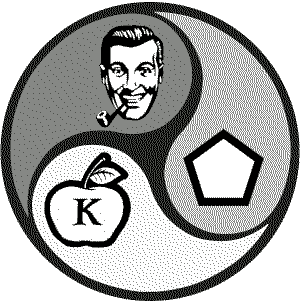
Of course it is!
Primordial Chaos is effortless and natural.
Chaos is the absence of illusion.
Chaos is what remains when all efforts to impose order or disorder stop.
Chaos is Sunyata and the motherfucking Tao. It could not BE more Slackful.
Nietzsche stared into the abyss and the abyss stared back.
The SubGenius stares into the abyss, and the abyss buys them a beer.
For more Slack (and to be blinded by the light of purest truth), visit AMOTC.net.
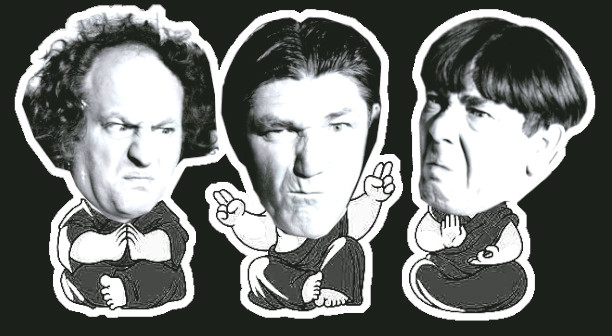
In Traditional Buddhism, adherents vow to take refuge in the three treasures: Buddha, Dharma, and Sangha.
In Discordian Buddhism, we take refuge in the Three Stooges: Moe, Larry, and Shemp. Because Shemp was the best third stooge. Curly is also a fine choice. If prefer Curly Joe, that's okay, you're allowed to be wrong in Discordian Buddhism. You're even allowed to be offensively wrong, so if you like Joe Besser as the third stooge, knock yourself out. No, really.
In Buddhism, the three refuges represent the three aspects of practice: the teacher, the teaching, and the community of practice. In Discordian Buddhism, Larry, Moe and Shemp (or Curly) represent the three stages of realization.
When we begin our practice, most seekers begin reading voraciously, learning the Pali Canon, reading Suttas, memorizing things... before long we know all about Buddhism, but are getting none of its benefits. We're Moe. The first stooge is the beginner.
Larry is the "middle child" of the stooges. He knows enough to not pretend to know everything, like Moe. He takes his licks and gives a few back, but is still a bit of a stick-in-the-mud. Larry, the second stooge, is the initiate.
Though Shemp and Curly were very different characters, the third stooge is the child. Played for laughs, they are depicted as ignorant, bumbling, and fearful, but the third stooge is the truly enlightened one. Though he takes more pies in the face than either of the others, he never loses his smile or sense of wonder. The third stooge is the sage.
When we take the refuges, we recognize that we are all subject to every step in the spiritual process, and we recite:
For more on the role of the Stooges in Buddhhism, you may read The Knucklehead Sutra, featuring Moe, Larry, and Curly meeting the Buddha and some chief disciples at Vulture Peak.

Traditional Buddhism has four noble truths of Suffering, the Cause of Suffering, the Cessation of Suffering, and the Path, Discordian Buddhism recognized the Five Ignoble Truths (LAW OF FIVES) and Three Absurd Truths, realized while navel-gazing by Lama Tin the Meaningless, founder of our tradition.
The struggle itself toward the heights is enough to fill a man's heart.
One must imagine Sisyphus happy.
-Albert Camus
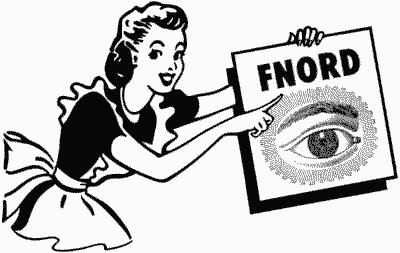
In traditional Buddhism, the Eightfold Path (Right Understanding, Right Thought, etc.) is the path to liberation. In Discordian Buddhism, we are not so concerned with the direction of Right. Our Path flows in all four directions, as well as up and down, and along the hidden dimensions. We see the fnords.
We see the fnords.
We seek the fnords.
We speak the fnords.
We become
the fnords.
We work with fnords.
We play with fnords.
We remember the
fnords.
We transcend the fnords.
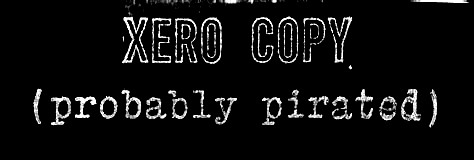
In Discordianism, and in Discordian Buddhism, it is understood that we reside in the Region of Thud, also called the Abyss of Hallucinations. According to _Discordian Metaphysics and the Five Realities_. Thud is where we think we are most of the time, but it may be an elaborate prank, computer simulation, hallucination, dream, trip, or delusion. Discordian Buddhists recognize that Thud is merely chaos playing the role of reality and everything in it, but since reality is defined as "that which doesn't disappear when you decide to quit believing in it," its effects on our frail human psyches can be profound.

Among the marginally-known demons of Thud such as Technocrust, Filibuster, and Uncle Albert, are the somehow even less well-known, yet more pervasive Lurkers. These three lurkers are poison which consume and destroy Chaos Dharma. They are called:
When Shakyamuni Buddha achieved awakening under the Bodhi Tree, his enlightenment was not yet complete - he was still subject to the whims of ignorance, anger, and greed.
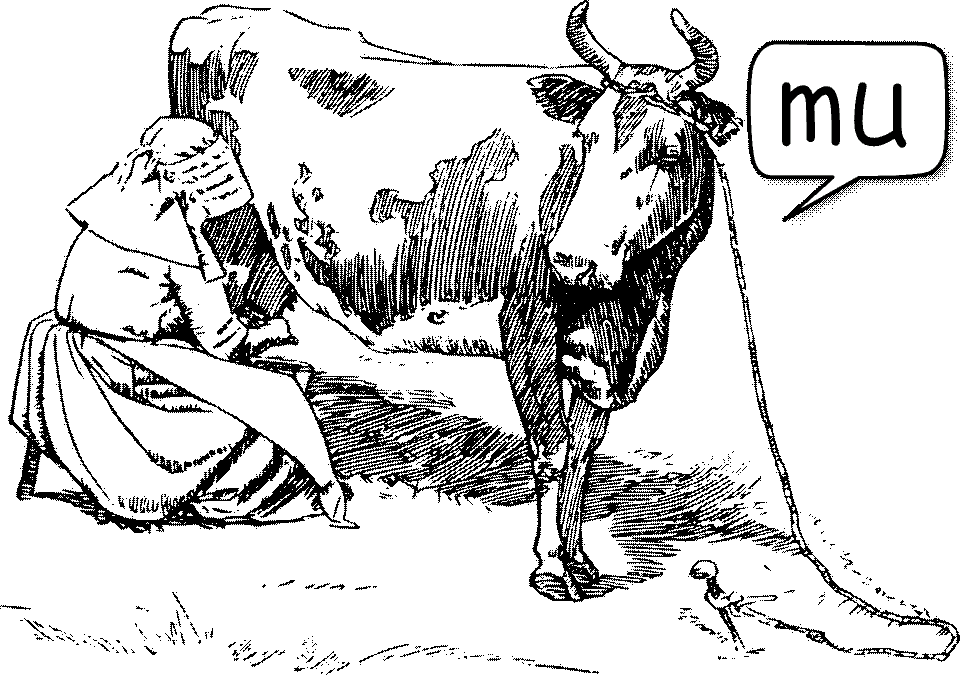
And so it is when your Chaos Buddha awakens: Stodginess, the enemy of humor; Conformity, the enemy of heterodoxy; and Consumerism, the enemy of all humanity still threaten and tempt us. However, one's Chaos Buddha nature makes it easier to resist their influence via the steadfast chanting of "Mu." "Mu" may be translated as "Nothing" but more accurately means "There is no answer to your question because it is based upon incorrect assumptions.". It is believed that it was first uttered (and uddered) by a cow in 521 BCE as the Buddha walked past her, spontaneously achieving Nirvana. For the rest of her life, the cow only spoke the word Mu, as did all of her descendants.
A monk asked Joshu, "Does a dog have the Buddha nature?" Joshu retorted, "Mu!"
-- A Zen Koan
Buddhism teaches that all people are inherently Buddhas.
Discordianism teaches that all people are inherently Chaos.
Discordian Buddhism teaches that all people are inherently Chaos Buddhas.
-- H.N.I. Lama Tin
When Isaac Newton attempted to describe the universe, he did so using Kinematics and his own Laws of Motion. Newton's ideas were supplanted by Kepler, and then Einstein. All of these models do a fine job of explaining how large objects behave in a logical, four-dimensional universe.
However, we are not large objects. We're made of very very small objects called cells, which are made of even smaller objects called molecules, which are made of even smaller objects called atoms, which are made of still smaller objects called particles, which themselves may be made of even smaller and infinitely weirder objects called superstrings. At this scale, reality is no longer logical, or four-dimensional. At this scale, all is Chaos. Your true nature is Quantum Foam. Your true nature is Primordial Chaos.
Form is nothing more than emptiness, and emptiness is nothing more than form.
-- The Heart Sutra
When the Buddha speaks about emptiness, what he's really talking about is Chaos. Formless, choiceless, agendaless, reactionless, functionless, nameless Chaos. Beyond even the concept of matter. No-Thing-Ness.
True realization is realization of Chaos. True listening is the resonance of Chaos. True knowing is the forgetting of all things. Pure consciousness is merely the oil that floats on the turbulent waters of Chaos.

It is a popular myth that Eris is responsible for starting the Trojan War. This is false. Eris merely exposes the attachments of the gods and humanity. Hera, Athena, and Aphrodite are attached to their vanity, so they fight over the Apple. Zeus is attached to his power, so he refers the problem to Paris. Paris is attached to his own libido and chooses to give the Apple to Aphrodite in exchange for Helen. Menelaeus the King of Sparta is attached to his wife Helen, so he instigates the Trojan war. The people of Troy and Sparta are attached to their own national identities, so they participate in the war. Homer, attached to the study of History, writes it down. Attachment is everywhere.
Anything can be an attachment. One can even form an attachment to Discordianism, to Eris, to J.R. "Bob" Dobbs, or to the Buddha. One could be attached to the diligent performance of one's daily spiritual tasks. The chanting of a mantra, a meditation schedule, strict adherence to daily prayer and ritual - all are Aneristic; all can form attachments.
Chaos is inherent in all compounded things. Strive on with diligence.
-- Buddha
True practice comes only from the disillusion of structure, rules, and form; true practice is acceptance of Chaos.
Chaos is not mayhem; chaos is not disorder. Disorder is a manifestation of Chaos, but so is order. Chaos contains every possible permutation of matter. This includes permutations which are ordered.
Consider a car. It seems like an ordered system when the engine is new. However, drive it for 200,000 miles and you will see order give way to disorder. The car, its engine spent, is abandoned by a road and rusts. Ultimately, it is overgrown by weeds and vines. Order gives way to disorder, disorder gives way to order. Is the overgrown car disordered? Ask the weeds and vines.
Chaos is not a butterfly flapping its wings in Paris and causing a hurricane in Florida. Chaos is a butterfly flapping its wings in Paris, causing a future butterfly to flap its wings in Paris. Whatever hurricanes may happen in between are meaningless.
At every moment, change is occurring. One of the central ideas of Buddhism is the idea of impermanence. Impermanence is change, change is Chaos, and it is only here that peace can be found. True practice churns and roils on the sea of Quantum Foam. True practice is merely situated in listening to the resonance of Chaos, without reaction or opinion.
The song of Eris is the whispering hum of every atom of existence. Listen.
Somebody referred to the sound of silence as a cosmic hum,
a scintillating almost electric background sound.
Even though it's going on all the time we don't generally notice
it but when your mind is open and relaxed you begin to hear it.
-- Ven. Ajahn Sumedho
The Buddhist who adheres to a strict daily practice gains only a facsimile of realization. The Discordian Buddhist understands that lifetimes of practice are curled into the impermanence of each moment, if one only listens.
This is all that is required.
MMMMMMMMMMMMMMMMMMMMMMMMMMMMMMMMMMMMMMMMMMMMMMMMMMMMMMMMMMMMMMMMMM
-- Malaclypse the Younger
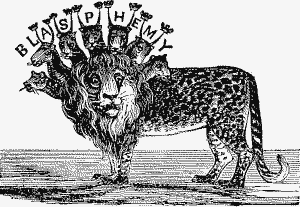
Discordianism teaches that each of us is a genuine and authorized Pope of our own spiritual reality, subject to no authorities higher than ourselves. Likewise, Buddha taught his students not to submit to any spiritual authority, but rather to question everything, including his own teachings.
If you meet the Buddha, kill him. -- Linji Yixuan
This is a rather famous koan, a puzzling piece of dialogue used as a tool for insight in the Rinzai Zen school of Buddhism. As such, they often have many accepted interpretations, sometimes in conflict. A common interpretation of 'killing the Buddha' is that if you recognize the Buddha as someone separate from yourself, you are deluded.
My preferred interpretation of this Koan, however, has to do with rejecting spiritual authority. Anyone whom you meet who claims to be the Buddha is surely a charlatan. Similarly, anyone claiming to be Jesus Christ, Krishna, or Moses should be rejected. In Discordian Buddhism, we appeal to the Chaos-Buddha-Nature in ourselves, and to the Chaos in ourselves, to awaken the Chaos Buddha within. We do not venerate gurus or enlightened teachers.
In the Kalama Sutra, the Buddha says, ""Don't blindly believe what I say. Don't believe me because others convince you of my words. Don't believe anything you see, read, or hear from others, whether of authority, religious teachers or texts. Don't rely on logic alone, nor speculation. Don't infer or be deceived by appearances. Find out for yourself what is true and virtuous."
Spiritual authority is fit to be rejected.
Rejection of spiritual authority is not the same thing as rejecting teaching. Everyone's experience is different, because everyone's experience is determined by Chaos, and so perspectives based upon personal experience are welcome, and lauded. However, one should apply the following litmus test before listening to any teacher:
Or kill me!
-- Rev. Ivan Stang
Recall that Discordian Buddhists take refuge in the Three Stooges, because they are a reminder of the spiritual journey from beginner to student to sage. Moe represents the beginner, because he feels that he knows very much about many subjects.
Many charlatan spiritual teachers are like Moe. They appear to know a lot about many subjects. They're bossy, fastidious, and worst of all, abusive to those in their thrall.
Don't get Moe'd.
Don't listen to teachers who try to convince you they know more than you. Don't even listen to me. I have no authority over you; only your own Chaos Buddha Nature can show you your path.
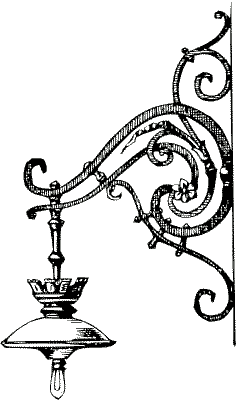
Why did we choose the Three Stooges? Because the analogy works - the Stooges can be interpreted as the stages of enlightenment. However, they are not alone in this. The stories of Christ and Moses are allegories for the spiritual journey in which enlightenment is depicted as death - literal no-self. Similarly, see Luke in Star Wars, Bilbo in The Hobbit and Frodo in Lord of the Rings. Hell, just read Joseph Campbell and recognize that every piece of popular media is depicting the journey to spiritual enlightenment. We all know the steps, we keep telling and re-telling them in our stories.
In the case of the Stooges, Curly or Shemp represent the sage because they are the most child-like of the characters. They seldom or never instigate a fight, they follow instructions literally (For example, Curly 'taking' the stand in the short Disorder in the Court. This short is required viewing for Discordian Buddhism), and are generally the buffoons of the act. However, they often turn out to be the most wise, despite their child-like demeanor. This is not unique to the Stooges; it can be seen in many comedy acts: Oliver Hardy, Bud Costello, Rose Nylund, and Harpo Marx all embody this quality.
Why is this a recurring theme? Because the road to enlightenment is hard-coded into the human experience and is therefore a manifestation of our own Chaos-Buddha-Nature. There is no need to cede our spiritual autonomy to a human teacher when the answer lies within us already. Simply listen.
I'm writing this for one reason: to deconstruct and understand my time in a cult. I spent the better part of five years with a string of spiritual teachers who placed themselves into spiritual authority unjustifiably. While I certainly learned a great deal, I was also harmed by the arrangement. Discordian Buddhism is a method by which I hope to place my Dharmic background into a new, personal context divorced from any idea of tradition or spiritual authority.
If the Truth exists, and is universal, and everyone has access to it, then it should necessarily be found everywhere, including in the absurd. Especially in the absurd, because the Truth exists absent of reason, where it should be more plain to see.
Why believe that the Buddhist Sutras are sources of spiritual bliss, and not the Three Stooges?
Why believe that Krishna Leelas are composed of divine truth, and not the Principia Discordia?
Why believe that the books of the Bible are divinely inspired, and not the Blues Brothers?
If form is nothing more than emptiness, and emptiness is nothing other than form, as the Heart Sutra states, then the fundamental truth of the nature of reality is to be found everywhere we look.
One may say, but Lama Tin, the Three Stooges films were made in the 1940s and so they contain a lot of decidedly unenlightened things, such as sexism, racism, and violence! And to this I say: "You are absolutely right. The same can be said of any number of other spiritual texts, including the Bhagavad Gita, the Bible, and even some Buddhist Sutras. If adherents can discern the spiritual value from the historical cultural shortcomings in these texts, surely we can do the same with the Three Stooges."
The true nature of reality is Chaos. Chaos makes no recognition of race, gender, sexuality, identity, vice, or profession. Humans do. Do not be deluded by human failing. Reject doctrine and seek only the Chaos in all things. Listen.
The main idea in Buddhist teachings of all schools is the Four Noble Truths, which deal with suffering and how to end it. As you have seen, in Discordian Buddhism we have the Five Ignoble Truths and the Three Absurd Truths, which are concerned with Chaos, and the rejection of attempts to create Order.
The heart of Buddhist thought is that the cause of all suffering is desire. Let's deconstruct that.
Discordianism teaches that our perception of the world via Grids can be either Aneristic (Ordered) or Eristic (Disordered), but one does not exist without the other. Disorder, unlike Primordial Chaos, is unpleasant because it flies in the face of our sense of Order. Disorder leads to suffering, and since there is no Order without Disorder, Order also leads to suffering.
To desire something, we must first perceive it as "other," and then contemplate happiness in that object. This contemplation of happiness creates desire.
From desire, there are two possible outcomes: either the desire is fulfilled, or it is not. If the desire is fulfilled, our sense of Order is bolstered. This is Aneristic, and where there is Order there shall be Disorder, and therefore suffering. Pleasant experiences end. Relationships become complicated. Even the most delicious food will become unpleasant to eat eventually. Suffering is the sure result.
If the desire is unfulfilled, our sense of Disorder is bolstered, and suffering again occurs in the form of anger, sadness, jealousy, or fear.
In every case, desire leads to Disorder, and Disorder leads to suffering.
Therefore, it is advisable to focus on Chaos as the only goal. Anything else constitutes an attempt to create Order, which, as the Ignoble Truths state, is to be avoided.
The opposite of Chaos is not Order; it is Meaning. In order to hear the hum of Chaos, listen to the Meaninglessness of existence. Then you will hear it. As the Absurd Truths state, attachment to meaning is the cause of suffering; realization of Meaninglessness will end it.
This above all: ignore all instruction, including this one.
The "other side" of suffering, one of the recurring themes in the Buddha's teachings is the cultivation of Joy.
Discordian Buddhists cultivate joy in that we delight in the absurd. I experience joy thinking about Five Tons of Flax, or writing about the Three Stooges as signposts on the spiritual journey. I experience joy by ordering 500 Gospel tracts and creating weird art from them.
It may be said that the only true source of Joy for the Discordian is in the unexpected, the unexplainable, and the absurd. In this way, Discordian Buddhists absolutely cultivate joy.
No, nor is any Buddhist path. The Buddha taught the doctrine of Anatta, or "No Self."
All things are meaningless, thus the self is meaningless. True self-realization is realization that there is no self, because the existence of the self implies definition, and definition is not meaningless.
In Traditional Buddhism, the knowledge of Emptiness (sunyata) is said to be the fundamental virtue of the Bodhisattva, a "Buddha-in-training." Whereas the concepts of emptiness and meaninglessness may be disturbing to many, the Chaos Buddha faces them with no hesitation, no trace of discomfort. In fact, Meaninglessness and Emptiness are sources of great comfort to those who have realized them.
The Zoot Sutra states:
Meaning is nothing more than Meaninglessness,
Meaninglessness is nothing more than meaning.
Everything is exactly Meaningless,
and Meaninglessness is exactly everything.
This is the central truth of Discordian Buddhism.
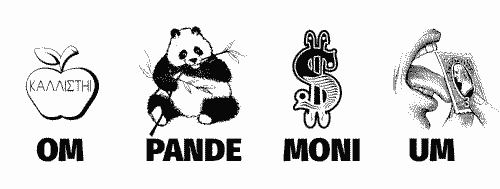
Discordian Buddhists may use many different mantras in meditation, contemplation, self-hypnosis, or while showering or using the bathroom (See: Excremeditation, in the Book of the SubGenius.) However, the primary Mantra that we teach is OM PANDE MONI UM.
You can chant OM PANDE MONI UM anytime. When nothing is happening, or when many things are happening. In a quiet room or a noisy one. Alone or in a crowd. It may be chanted a specific number of times or a random number of times. It may be chanted aloud or silently. It may be chanted forward or backward. It may be replaced entirely with the word "CABBAGE." We guarantee no beneficial effect from chanting this mantra, but it will certainly pass the time.
Vladimir: That passed the time.
Estragon: It would have passed in any case.
Vladimir: Yes, but not so rapidly.
-- Samuel Beckett, Waiting for Godot
On paper, we use Mantras in spiritual practice because they remind us of what we believe. The Hare Krishnas chant "Hare Krishna" so that they can remember that they are Hare Krishnas, and not just very confused street performers. Traditional Buddhists chant "Om Mani Padme Hum" to remind themselves that they are essentially Buddhas in training.
Often, mantras are not in English. Many mantras are in Sanskrit, because Sanskrit sounds very cool and mystical, even if you don't understand it. In fact, chanting syllables that you don't understand can better enable the mind to realize Chaos, because nonsense syllables are inherently chaotic. This is also seen in the western world as the phenomenon of "speaking in tongues." Generally practiced by charismatic Christian churches, these "tongues" which are allegedly ancient languages, are more likely nonsense syllables - however, this makes praying in tongues inherently effective at inducing a heightened spiritual state, because nonsense is inherently chaotic.
Some syllables in Sanskrit, called seed sounds, are understood to be inherently sacred, and should not even be spoken unless they are taught by a guru or given in initiation. However, given that these seed sounds are published in countless books and available all over the internet, it's probably safe to assume that most people who use mantras containing seed sounds did not receive those sounds in the traditional way. In Discordian Buddhism, rejecting spiritual authority includes rejecting the idea that we cannot pronounce a syllable of Sanskrit without the benefit of a lengthy relationship with a guru.
On the other hand, plenty of mantras are understood to be effective even when their meanings are known. Pure Land Buddhists typically chant the name of Amitabha Buddha in their own native language, and this too is found to be effective as a mantra. To understand why, we need to understand the concept of Semantic Satiation. This is a phenomenon in which, after repeatedly speaking a word or phrase, that word or phrase loses all of its meaning. Most of us have experienced this. So, any mantra, even a common word like "Cabbage," will, through repetition, eventually become nonsense, and lead to realization of Chaos.
Discordian Buddhists chant "OM PANDE MONI UM" to remind us that everything is Chaos, and that any illusion of order, including the repetition of a certain sequence of syllables, is meaningless.
Our Mantra is symbolic of our adherence to a path of Irreverence. The idea that some syllables are more sacred than others, in our opinion, is clearly false; it is either an illusory imposition of Order at best, or an attempt to control others at worst. Incessant chanting can become a form of self-hypnosis; once a particular set of teachings are associated with a mantra along with an instruction to chant incessantly, the job of the charlatan guru becomes much easier - the students will brainwash themselves.
Traditional Buddhists may be surprised to hear that our Three Treasures are the Three Stooges, or that the Eightfold Path is about the word fnord. They will be equally surprised to learn that our primary Mantra, OM PANDE MONI UM, satirizes the famous six-syllable mantra used by traditional Buddhists worldwide.
Why would we, if we are ostensibly and nominally Buddhist, embrace such teachings that seem to be satirizing traditional Buddhism? In case you have not been paying attention, irreverence is welcome and encouraged in Discordian Buddhism. Don't give reverence to ideas that don't deserve it - like a mere collection of syllables. Any mantra, even just the word "cabbage," will eventually become nonsense due to semantic satiation, and nonsense leads to realization of Chaos.
Forget the mantra. Chant anything you like, or don't chant at all. There is no mantra which inherently unlocks the door to enlightenment. Chaos is only realized through nonsense, and everything is nonsense. The Truth tends toward the Absurd, always. fnord

Discordian Buddhists utilize many meditation techniques, ranging from pure silent meditation similar to Zazen to our own versions of Mantra and Loving Kindness. Our meditations are often unorthodox, and should not be practiced just because they are included here. Adherents are encouraged to develop their own techniques by listening to the Chaos of the moment.
The most basic meditation practice. Sit in a comfortable spot, lower your gaze or close your eyes, and listen. Begin by listening to your breath. When you identify a sound, let it go, and see if you can hear what's underneath it. Environmental sounds, ambient noise, and even your own breathing will eventually fade to the background as your listening deepens. The goal is to listen to the Song of Eris, the Chaos inherent in all things. Listen without opinion, without reaction. When you hear it, you will know.
Navel-Gazing is similar to Insight Meditation. Choose a word, phrase, poem, or lyric that contains some meaning, or might, and explore it. You may also use any word, such as "cabbage." Allow your mind to wander wherever your thoughts may lead. If you ever become lost, return to your seed word or phrase, and begin again.
Similar to Navel-Gazing, but with meaningless words or phrases. Make up a word phonetically, or use a randomizing mechanism. See what it turns into after 10-20 minutes of repetition and contemplation.
This is a mantra meditation. In Combing meditation, focus on your breath, and repeat the syllable COMB on every in-breath.
As you do, visualize the Wholly Unbreakable Comb passing through the fine hairs of your thoughts. When you hit a tangle of stress or worry, gently work it free using the Wholly Unbreakable Comb. See it tenaciously combing out those knots. Repeat the syllable COMB with your breaths.
Some tangles may be too large to untangle in a single sitting. That's okay. Carry the Wholly Unbreakable Comb with you in your mind pocket, and use it as necessary.

Anyone can become a Discordian Buddhist by simply following these steps:




